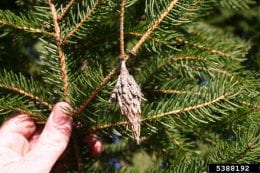By Dr. Cheryl Boyer
It’s that time of the year when it’s both very hot and, likely, very dry. While it’s important to water landscape ornamentals all year long, now is a critical time to make sure plants have all the resources they need.
We have several publications about best practices for watering:
- Watering Newly Planted and Young Trees and Shrubs
- Watering Established Trees and Shrubs
- Watering Raised Beds, Berms, Containers, and Houseplants
Newly planted trees (within their first year) should be watered at least weekly but check the soil to make sure it’s draining well. Slow-release watering methods like micro-pore bags and 5-gallon buckets with small (1/8-inch) drainage holes are a good way to apply irrigation to trees and some shrubs. However, remember to remove the bags when they are empty to ensure good airflow around plant stems and reduce pests and diseases. Removing turfgrass and other ornamental plants to at least the tree dripline (or beyond) will help trees access more water and grow more quickly—make sure to mulch the turfgrass-free zone to help retain applied water.
Established trees will benefit from a thorough soaking (to a depth of 12 inches out to and beyond the drip line) every 3 to 4 weeks. Established shrubs need water every 2 to 3 weeks during this drought- and heat-prone time of year. Plants growing in raised beds and berms may need to be watered every 1 to 2 weeks. Soaker hoses work well for watering established trees and shrubs.
You may want to consider taking advantage of a light rainfall (if you get one in July and August) by watering immediately afterward to help moisture move deeper into the root zone.
Any way you slice it, watering is a good thing. There are many other factors to consider for successful planting, but right now watering is top of the list. Keep it up—plants are thirsty just like you!

